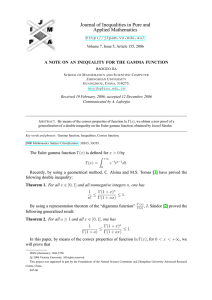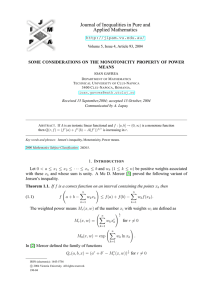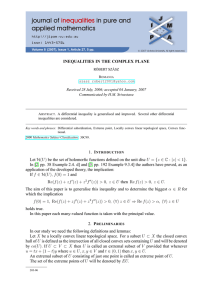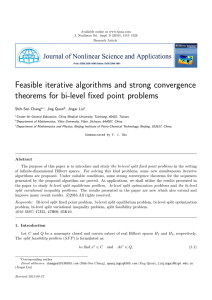SUPERQUADRACITY OF FUNCTIONS AND REARRANGEMENTS OF SETS Communicated by S.S. Dragomir
advertisement
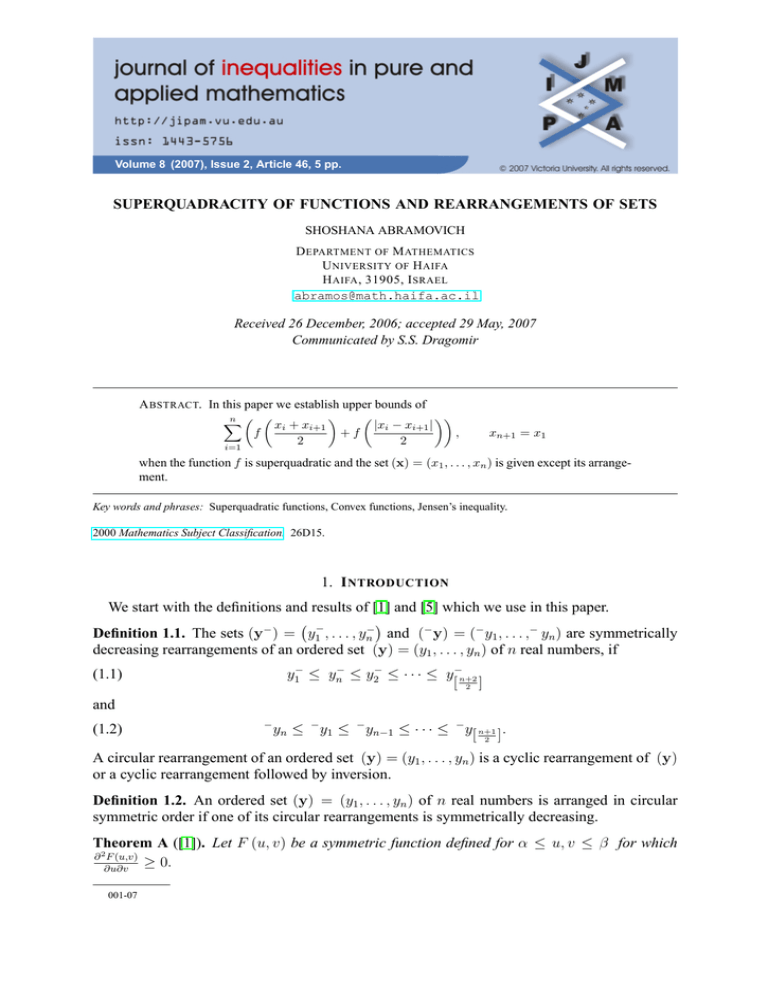
Volume 8 (2007), Issue 2, Article 46, 5 pp. SUPERQUADRACITY OF FUNCTIONS AND REARRANGEMENTS OF SETS SHOSHANA ABRAMOVICH D EPARTMENT OF M ATHEMATICS U NIVERSITY OF H AIFA H AIFA , 31905, I SRAEL abramos@math.haifa.ac.il Received 26 December, 2006; accepted 29 May, 2007 Communicated by S.S. Dragomir A BSTRACT. In this paper we establish upper bounds of n X |xi − xi+1 | xi + xi+1 +f , f 2 2 i=1 xn+1 = x1 when the function f is superquadratic and the set (x) = (x1 , . . . , xn ) is given except its arrangement. Key words and phrases: Superquadratic functions, Convex functions, Jensen’s inequality. 2000 Mathematics Subject Classification. 26D15. 1. I NTRODUCTION We start with the definitions and results of [1] and [5] which we use in this paper. Definition 1.1. The sets (y− ) = y1− , . . . , yn− and (− y) = (− y1 , . . . ,− yn ) are symmetrically decreasing rearrangements of an ordered set (y) = (y1 , . . . , yn ) of n real numbers, if y1− ≤ yn− ≤ y2− ≤ · · · ≤ y −n+2 [ 2 ] (1.1) and (1.2) − yn ≤ − y1 ≤ − yn−1 ≤ · · · ≤ − y[ n+1 ] . 2 A circular rearrangement of an ordered set (y) = (y1 , . . . , yn ) is a cyclic rearrangement of (y) or a cyclic rearrangement followed by inversion. Definition 1.2. An ordered set (y) = (y1 , . . . , yn ) of n real numbers is arranged in circular symmetric order if one of its circular rearrangements is symmetrically decreasing. Theorem A ([1]). Let F (u, v) be a symmetric function defined for α ≤ u, v ≤ β for which ∂ 2 F (u,v) ≥ 0. ∂u∂v 001-07 2 S HOSHANA A BRAMOVICH Let the set (y) = (y1 , . . . , yn ), α ≤ yi ≤ β, i = 1, . . . , n be given except its arrangement. Then n X F (yi , yi+1 ) , (yn+1 = y1 ) i=1 is maximal if (y) is arranged in circular symmetrical order. Definition 1.3 ([5]). A function f , defined on an interval I = [0, L] or [0, ∞) is superquadratic, if for each x in I, there exists a real number C (x) such that f (y) − f (x) ≥ C (x) (y − x) + f (|y − x|) for all y ∈ I. A function is subquadratic if −f is superquadratic. Lemma A ([5]). Let f be a superquadratic function with C (x) as in Definition 1.3. (i) Then f (0) ≤ 0. (ii) If f (0) = f 0 (0) = 0, then C (x) = f 0 (x) whenever f is differentiable. (iii) If f ≥ 0, then f is convex and f (0) = f 0 (0) = 0. The following lemma presents a Jensen’s type inequality for superquadratic functions. Lemma P B ([6, Lemma 2.3]). Suppose Pthat f is superquadratic. Let xr ≥ 0, 1 ≤ r ≤ n and let x = nr=1 λr xr , where λr ≥ 0, and nr=1 λr = 1. Then n n X X λr f (xr ) ≥ f (x) + λr f (|xr − x|) . r=1 r=1 If f (x) is subquadratic, the reverse inequality holds. From Lemma B we get an immediate result which we state in the following lemma. Lemma C. Let f (x) be superquadratic on [0, L] and let x, y ∈ [0, L], 0 ≤ λ ≤ 1, then λf (x) + (1 − λ) f (y) ≥ f (λx + (1 − λ) y) + λf ((1 − λ) |y − x|) + (1 − λ) f (λ |y − x|) t−1 X ≥ f (λx + (1 − λ) y) + f 2λ (1 − λ) |1 − 2λ|k |x − y| k=0 + λf (1 − λ) |1 − 2λ|t |x − y| + (1 − λ) f λ |1 − 2λ|t |x − y| . If f is positive superquadratic we get that: t−1 X λf (x) + (1 − λ) f (y) ≥ f (λx + (1 − λ) y) + f 2λ (1 − λ) |1 − 2λ|k |x − y| k=0 More results related to superquadracity were discussed in [2] to [6]. In this paper we refine the results in [7] by showing that for positive superquadratic functions we get better bounds than in [7]. Theorem B ([7, Thm. 1.2]). If f is a convex function and x1 , x2 , . . . , xn lie in its domain, then n X x1 + · · · + xn f (xi ) − f n i=1 n−1 x1 + x2 xn−1 + xn xn + x1 ≥ f + ··· + f +f . n 2 2 2 J. Inequal. Pure and Appl. Math., 8(2) (2007), Art. 46, 5 pp. http://jipam.vu.edu.au/ S UPERQUADRACITY AND R EARRANGEMENTS 3 Theorem C ([7, Thm. 1.4]). If f is a convex function and a1 , . . . , an lie in its domain, then (n − 1) [f (b1 ) + · · · + f (bn )] ≤ n [f (a1 ) + · · · + f (an ) − f (a)] , where a = a1 +···+an n and bi = na−ai , n−1 i = 1, . . . , n. 2. T HE M AIN R ESULTS Theorem 2.1. Let f (x) be a superquadratic function on [0, L] . Then for xi ∈ [0, L] , i = 1, . . . , n, where xn+1 = x1 , n n−1X (2.1) f n i=1 n X xi + xi+1 ! 2 i=1 ≤ +f n X |xi − xi+1 | 2 i=1 n X ! −f f (xi ) !! i=1 n X xi i=1 ! n n 1X − f n i=1 ! n X x j x i − n j=1 holds. If f 000 (x) ≥ 0 too, then n (2.2) n−1X f n i=1 n X xi + xi+1 ! n X |xi − xi+1 | !! +f 2 2 i=1 n x bi + x bi+1 n−1X |b xi − x bi+1 | f +f ≤ n i=1 2 2 ! ! ! n n n n X X X X xi 1 xj ≤ f (xi ) − f − f xi − , n n n i=1 i=1 i=1 i=1 j=1 where (b x) = (b x1 , . . . , x bn ) is a circular symmetrical rearrangement of (x) = (x1 , . . . , xn ) . Example 2.1. The functions f (x) = xn , n ≥ 2, x ≥ 0, and the function f (x) = x2 log x, x > 0, 0, x=0 are superquadratic with an increasing second derivative and therefore (2.2) holds for these functions. Proof. Let f be a superquadratic function on [0, L] . Then by Lemma B we get for 0 ≤ α ≤ 1, 1 ≤ k ≤ n and xi ∈ [0, L] , xn+1 = x1 , (2.3) n X i=1 n n n−k X kX f (xi ) = f (xi ) + f (xi ) n i=1 n i=1 n n n−k X kX = (αf (xi ) + (1 − α) f (xi+1 )) + f (xi ) n i=1 n i=1 J. Inequal. Pure and Appl. Math., 8(2) (2007), Art. 46, 5 pp. http://jipam.vu.edu.au/ 4 S HOSHANA A BRAMOVICH n n−k X ≥ f (αxi + (1 − α) xi+1 ) n i=1 n n−k X (αf ((1 − α) |xi+1 − xi |) + (1 − α) f (α |xi+1 − xi |)) n i=1 ! Pn Pn X n x x 1 i i=1 i +k f + f xi − i=1 . n n n i=1 + For k = 1 and α = 21 we get that (2.1) holds. 2 F (u,v) If f 000 (x) ≥ 0, then ∂ ∂u∂v ≥ 0, where F (u, v) = f (u + v) + f (|u − v|) , Therefore according to Theorem A, the sum n X xi + xi+1 |xi + xi+1 | f +f , 2 2 i=1 u, v ∈ [0, L] . xn+1 = x1 , is maximal for (b x) = (b x1 , . . . , x bn ) , which is the circular symmetric rearrangement of (x) . Therefore in this case (2.2) holds as well. Remark 2.2. For a positive superquadratic function f , which according to Lemma A is also a convex function, (2.1) is a refinement of Theorem B. If f 000 (x) ≥ 0, (2.2) is a refinement of Theorem B as well. Remark 2.3. Theorem B is refined by Pn n X n−1 i=1 xi f (xi ) − f ≥ n n i=1 ! n X x bi + x bi+1 f 2 i=1 n n−1X xi + xi+1 f , ≥ n i=1 2 because a convex function f satisfies the conditions of Theorem A for F (u, v) = f (u + v) . The following inequality is a refinement of Theorem C for a positive superquadratic function f , which is therefore also convex. The inequality results easily from Lemma B and the identity ! n n n X X 1 X f (ai ) = f (aj ) (1 − δij ) n − 1 i=1 i=1 j=1 (where δij = 1 for i = j and δij = 0 for i 6= j), therefore the proof is omitted. Theorem 2.4. Let f be a superquadratic function on [0, L] , and let xi ∈ [0, L], i = 1, . . . , n. Then ! ! n n X X n f (xi ) − f (x) − f (yi ) n−1 i=1 i=1 ! n X n n X 1 1 X ≥ f (|yi − xj |) (1 − δij ) + f (|x − xi |) , n − 1 i=1 j=1 n − 1 i=1 P i , i = 1, . . . , n. where x = ni=1 xni , yi = nx−x n−1 J. Inequal. Pure and Appl. Math., 8(2) (2007), Art. 46, 5 pp. http://jipam.vu.edu.au/ S UPERQUADRACITY AND R EARRANGEMENTS 5 R EFERENCES [1] S. ABRAMOVICH, The increase of sumsand products dependent on (y1 , . . . , yn ) by rearrangement of this set, Israel J. Math., 5(3) (1967). [2] S. ABRAMOVICH, S. BANIĆ AND M. MATIĆ, Superquadratic functions in several variables, J. Math. Anal. Appl., 327 (2007), 1444–1460. [3] S. ABRAMOVICH, S. BANIĆ AND M. KLARICIĆ BACULA, A variant of Jensen-Steffensen’s inequality for convex and superquadratic functions, J. Ineq. Pure & Appl. Math., 7(2) (2006), Art. 70. [ONLINE: http://jipam.vu.edu.au/article.php?sid=687]. [4] S. ABRAMOVICH, S. BANIĆ, M. MATIĆ AND J. PEČARIĆ, Jensen-Steffensen’s and related inequalities for superquadratic functions, to appear in Math. Ineq. Appl. [5] S. ABRAMOVICH, G. JAMESON Math. Roum., 47 (2004), 3–14. AND G. SINNAMON, Refining Jensen’s inequality, Bull. Sci. [6] S. ABRAMOVICH, G. JAMESON AND G. SINNAMON, Inequalities for averages of convex and superquadratic functions, J. Ineq. Pure & Appl. Math., 5(4) (2004), Art. 91. [ONLINE: http: //jipam.vu.edu.au/article.php?sid=444]. [7] L. BOUGOFFA, New inequalities about convex functions, J. Ineq. Pure & Appl. Math., 7(4) (2006), Art. 148. [ONLINE: http://jipam.vu.edu.au/article.php?sid=766]. J. Inequal. Pure and Appl. Math., 8(2) (2007), Art. 46, 5 pp. http://jipam.vu.edu.au/
